
Art | Resources
Confused About Labels on Leather Boots

Duckfeet boots online
Question from Heather
Hi Debra,
I have finally found non toxic GOTS certified sneakers by ETIKO and they are amazing aside from the shipping price. Sandals from Soft Star Shoes work for summer with their sandals. I fit in the kids size of rain boots from Stonz. Now I am hunting for winter boots and stuck. I looked at Duckfeet and feel confused with their wording. I called to get clarification but at times people say “eco friendly” leather and other times vegi tanned. Can you please explain if salt tanning is what is toxic in leather? Is “eco friendly” and “Zero Chrome” leather going to still be toxic free for the most part. Would you endorse Duckfeet?
Debra’s Answer
One of the problems in choosing materials is inconsistent labeling.
This is why it’s best to choose materials based on details rather than buzzwords, unless it’s a brand name, like Hoween Leather , which stands for meeting a certain standard that they have defined.
“Vegetable tanned” leather is the preferred process. And it’s becoming more and more available.
I don’t see any leather called “salt tanned.”
“Zero Chrom” leather might be OK but might contain some chemicals other than chrome.
The Duckfeet website says, “Vegetable-tanned leather midsoles and uppers give feet space to breathe and naturally transport moisture away from the skin. All-natural, shock-absorbing crepe rubber is used for the outsole, which can be re-soled…Each pair of Duckfeet is handcrafted in Europe without the use of synthetic materials.” That seems very clear to me. Vegetable-tanned.
Sounds good to me. Ask if they put any toxic substances on the shoes to waterproof the leather.
“Nontoxic Vinyl Plank Flooring”?????

CORRECTION
On 23 January 2018 I published the question and answer below. I have to admit I had all of my attention on the claim of this vinyl flooring being “nontoxic” and so didn’t actually look at the flooring itself.
Another reader contacted me about this same product but asked the question in a different way.
So now I want to give a different answer, which is about the product, instead of the claim that it is nontoxic.
These “vinyl planks” are made from a fairly new material called wood polymer composite (WPC). It is a form of vinyl that combines real wood fibers and PVC to create a flooring material that is dimensionally stable, resilient, and waterproof. I can see the benefits of doing this, as this is much better performance than wood.
It’s a “click” installation, which means it is one piece with a tongue-and-groove interlocking edge and an underlayment.
I called a manufacturer of WPC flooring and the materials are, from top to bottom:
- Polyurethane finish
- PVC top layer
- PVC+wood composite core
- polyurethane foam cushion on the bottom
So it’s all petroleum except for the wood particles.
Now question from the second reader was: it’s vinyl, is it outgassing phthalates?
Well, no. It’s hard vinyl so it wouldn’t have phthalates.
So is it OK to use if it’s not outgassing phthalates?
And that’s the difficult question.
It has long been known that the vinyl chloride monomer itself is hazardous to health. After studies in the 1970s showed that VCM causes cancer, the manufacturing process was completely closed to eliminate worker exposure. But consumers don’t have that same protection. According to the Centers for Disease Control, it is possible for extremely low levels of VCM to remain in PVC and be released from the plastic during use. These levels are considered to be totally harmless by health authorities for exposure through food packaging and beverage bottles. However, food packaging is a single exposure, which is not the same as the repeated exposure that happens from a consumer product (such as vinyl flooring). The current Occupational and Health Administration (OSHA) permissible exposure limit is 1 part vinyl chloride per million parts of air over an 8-hour workshift—an infinitesimal amount.
So it’s within the realm of possibility that enough VCM could outgas over time and be trapped and concentrated within a room or a home that it could be a problem.
But beyond this is my consideration about biocompatibility. And this is actually my #1 concern. Toxicology doesn’t address this. There is an exchange between our bodies and the natural world that happens in ways we aren’t even aware of or understand. But it happens.
Wood feels good to me. Plastic doesn’t. And I just wouldn’t lay 2000 square feet of carcinogenic VCM plastic in my house, regardless of measurable outgassing or not.
So that’s my answer about WPC.
Debra 🙂
This week I received a question from a reader. In the context of asking a completely different question, she said. “We are going to replace the current flooring with non toxic vinyl plank flooring.”
Nontoxic vinyl plank flooring????
I wrote back to her and asked what vinyl flooring she thought was nontoxic and why.
She said, “We are using GoHaus Luxury vinyl planks. They are floorscore certified. Have I been tricked? Is this not a safe product to use?”
And here is my response to her.
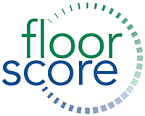 FloorScore is an indoor air quality certification for for hard surface flooring materials, adhesives, and underlayments.
FloorScore is an indoor air quality certification for for hard surface flooring materials, adhesives, and underlayments.
It was developed by Scientific Certification Systems in partnership with the Resilient Floor Covering Institute (RFCI), a leading industry trade association of flooring manufacturers and suppliers. FloorScore qualifies flooring products for many green building programs, including LEED v4, WELL, BREEAM, and CHPS.
Floorscore is administered by the RFCI, with SCS as the exclusive certification body.
Their website says “By testing representative product samples and focusing strictly on the relevant chemicals of concern, we deliver the results you need without excessive testing.” So they are not testing for all chemicals.
The standards for FloorScore are outlined in Indoor Air Quality Product Performance Standard for Building Interiors.
I looked through this document, but could not find any actual standard that tells what chemicals are being tested for and what amounts are allowed. What it says is:
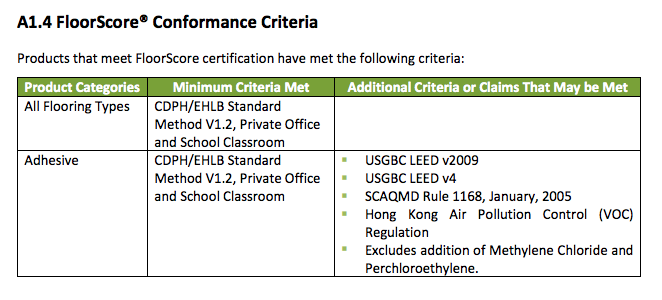
So I found the CDPH/EHLB Standard Method. Version 1.1. I couldn’t find version 1.2 online. Here’s the list of what they test for.
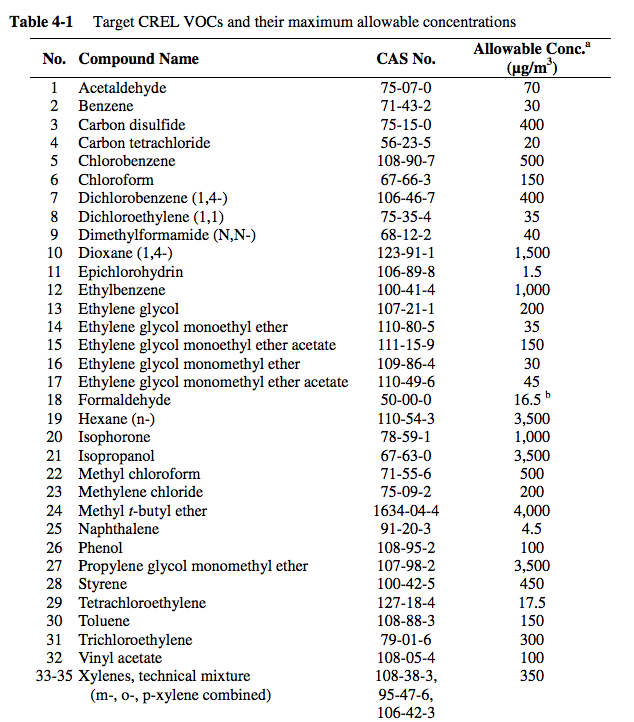
What needs to be tested for PVC vinyl flooring is PHTHALATES. There are no phthalates on this list of chemicals being tested.
So they can certify vinyl flooring that outgasses phthalates to “meet their standard.”
GREENGUARD does the same thing. They certify crib mattresses that outgas phthalates by not testing for them.
So I would not consider this FloorScore certified PVC flooring nontoxic.
This type of certification program where the industry gets together and certifies their products to be acceptable for indoor air quality is suspicious to me. I often see these programs (the carpet industry has one too) certifying products I would not recommend based on research of the toxicity of the materials they are using.
Medley
 Custom sofas built with your choice of materials—made in 4 weeks in Los Angeles. “None of our fabrics have fire retardants or stain finishes and we even offer 100% natural like cotton, hemp and wool, and some certified organic textiles as well..” This is a morph of the custom sofas that used to be at Viesso, by the original founders. “Realizing there is still so much more to do to disrupt the furniture industry, we knew it was time to break off our collection as its own brand.” Like Viesso, Medley lets you customize every aspect of your sofa, which gives you a lot of choice and requires that you make good choices. Standard materials are better than average but not really toxic-free, so skip those and go for the natural latex, organic cottons, They will send samples, and let you live with the finished sofa for 100 days. Free shipping (both ways if you return it). And they finance.
Custom sofas built with your choice of materials—made in 4 weeks in Los Angeles. “None of our fabrics have fire retardants or stain finishes and we even offer 100% natural like cotton, hemp and wool, and some certified organic textiles as well..” This is a morph of the custom sofas that used to be at Viesso, by the original founders. “Realizing there is still so much more to do to disrupt the furniture industry, we knew it was time to break off our collection as its own brand.” Like Viesso, Medley lets you customize every aspect of your sofa, which gives you a lot of choice and requires that you make good choices. Standard materials are better than average but not really toxic-free, so skip those and go for the natural latex, organic cottons, They will send samples, and let you live with the finished sofa for 100 days. Free shipping (both ways if you return it). And they finance.
VOCs from Consumer Products Now Produce more Smog Than Cars
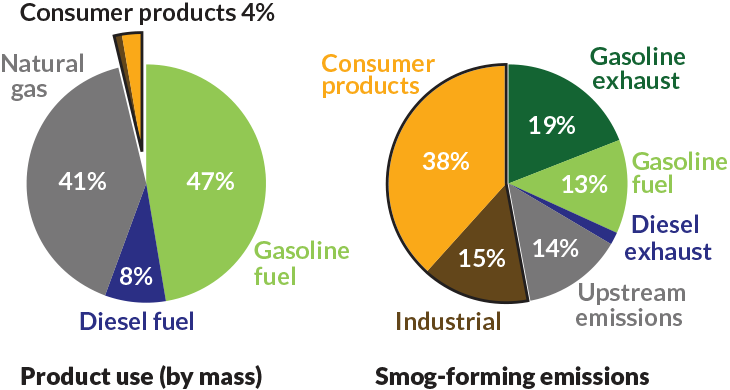
For decades, the focus on the source of outdoor air pollution has been on emissions from burning fuel from automobiles and factories.
But a new study shows “In urban areas, emissions from consumer goods such as paint, cleaning supplies and personal care products now contribute as much to ozone and fine particulate matter in the atmosphere as do emissions from burning gasoline or diesel fuel.”
Apparently programs to reduce pollution from car exhaust has been so successful that researchers are now able to see the impacts of other sources.
The study focused on VOCs that are derived from petroleum. Some VOCs can be harmful when directly inhaled, but they can also react with other molecules in the air to create ozone and other components of smog.
“15 times as much oil and natural gas is used as fuel than ends up in consumer products ranging from soaps, shampoos and deodorants to air fresheners, glues and cleaning sprays. And yet these everyday products were responsible for 38 percent of the VOC emissions, the researchers found, while gasoline and diesel emissions accounted for only 33 percent.”
SCIENCE NEWS: Household products make surprisingly large contributions to outdoor air pollution
Mango Wood

Question from Bonnie Johnson
Hi Debra,
I have been shopping for a new coffee table for my living room. I have noticed a lot of furniture made with mango woods. They are sold at Pier 1 and Cost Plus etc. Are they safe?
Debra’s Answer
Mango woods a new “sustainable” choice for furniture, as an alternative to traditional woods like oak and maple.
Mango trees are abundant in India, Southeast Asia, Mexico, Brazil and Australia, where mango is a popular fruit. In fact, mangoes are actually the most popular fruit in the world. I love them and often eat them myself.
Mango wood is the byproduct of an already thriving industry,
Once the trees get too tall to easily harvest the fruit, or stop bearing fruit altogether, they are harvested for timber and a new generation of trees is planted.
Harvesting wood that was previously burnt or left to break down naturally provides extra income to mango farmers, and gives furniture manufacturers an affordable hardwood that has the strength to bear weight needed for tables and chairs, yet is soft enough to work with easily.
Mango wood also happens to be water resistant.
It requires monthly polishing to avoid cracking due to dehydration.
Some natural ways to protect your mango wood.
Apparently mango wood is other [chemically treated before furniture manufacturing to prevent fungus attack]. Chromiated Copper Arsenate (CCA) and Copper Come Boron (CCB) wood preservatives are used, CB being less toxic.
It’s likely virtually all mango wood is treated and unlikely that they will tell you this at the point of sale.
However, these preservatives are not volatile and the particles could be contained with several coats of a toxic-free wood finish.
Chair Pads with Natural Fill
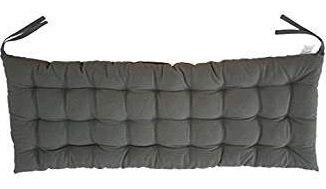
Buy 100% cotton chair and bench pads online.
Question from Stacey
Hi Debra,
I am trying to find affordable chairs for my kitchen table. I have uncomfortable metal chairs now and would like to at least add chair pads. I found some cotton-covered pads, however, the batting is a polyester fill. I cannot find any chair pads with a cotton batting. Would you recommend not using anything with a polyester fill?
Thanks!
Debra’s Answer
I know something about this. I have a metal desk chair and have the same problem.
Before that I had a wood desk chair with the same problem.
Unfortunately you can’t yet go into a store and purchase pillows with natural fill. All they sell is polyester. But online you can get pillows with cotton or wool or kapok fill that are quite comfortable.
I just bought the pillows and then wrapped cotton fabric around them with a design I liked. I didn’t even sew covers.
However, now—and I know this is going to sound funny, but it works—I sit on a folded plush cotton bath rug. It stays in place on the chair better.
You want to look for a “cotton chenille” rug WITHOUT a non-skid backing. Reversable rugs have no backing, just 100% cotton.
You can also just toss them in the washer and wash them and fluff them up in the dryer.
And if you want more plush, just pile them up on your chair until it is “just right.
Now that I said all that, I actually found some seat cushions on amazon with cotton fabric and cotton fill.
Shepherd’s Dream makes an organic wool and cotton Chair Pillow.
White Lotus Home makes their own pillows in many sizes with different organic filling.
And if you don’t find the size you are looking for, the would probably custom make it for you.
So see, there are lots of options.
Consumer Product Safety Commission Bans 5 More Phthalates in Toys and Child Care Products

Effective April 26, a new ruling with ban the use of five more phthalates in toys and child care products. This is in addition to the three phthalates in 2009, bringing to eight the total number of phthalates restricted from use in children’s toys and child care articles in concentrations exceeding 0.1 percent.
Phthalates are a common ingredient in soft vinyl and easily outgassed.
But watch out. Even if you see “phthalate-free” on a children’s product label, that doesn’t mean they contain zero phthalate. This refers only to the eight banned phthalates. There are still at least 18 other phthalates that could be present that have not been banned. All phthalates easily outgas from any plastics that contain them.
Research links phthalates with problems with the endocrine system and the liver, as well as cancer.
Numerous U.S. government agencies including the Centers for Disease Control and Prevention, The U.S. Department of Health, and the U.S. Food and Drug Administration (FDA) have expressed concern about phthalates.
In February 2009, the Consumer Product Safety Commission (CSPC) permanently banned three types of phthalates from crib mattresses, children’s toys, and other child care articles, specifically:
- di-(2-ethylhexyl) phthalate (DEHP)
- dibutyl phthalate (DBP)
- benzyl butyl phthalate (BBP)
At the same time, they placed a ban on an interim basis on three more types of phthalates, specifically:
- diisononyl phthalate (DINP)
- diisobutyl phthalate (DIBP)
- Di-n-octylphthalate (DnOP).
The Consumer Product Safety Improvement Act of 2008 also required the CPSC to appoint a Chronic Hazard Advisory Panel (CHAP) to “review the potential effects on children’s health of all phthalates and phthalate alternatives in children’s toys and childcare articles.” This review included the cumulative effects of exposure to multiple phthalates from all sources.
After nine years of review, the CPSC issued a final rule, effective April 25, 2018, prohibiting children’s toys and child care articles that contain concentrations of more than 0.1 percent on five additional phthalated, specifically:
- diisononyl phthalate (DINP)
- diisobutyl phthalate (DIBP)
- di-n-pentyl phthalate (DPENP)
- di-n-hexyl phthalate (DHEXP)
- dicyclohexyl phthalate (DCHP).
The Congressional prohibition on three phthalate chemicals under the CPSIA remains in full force and effect.
This seems to be the end of the investigation by the CPSC into phthalates. But there are other phthalates that may have similar health effects.
In 2014 the CHAP released “Report to the US Consumer Product Safety Commission by the Chronic Hazard Advisory Panel on Phthalates and Phthalate Alternatives.”
After assessing the risks of 14 phthalates (a list of “the most common phthalates” numbers 25 and there are certainly more) the CHAP found, “Although phthalates cause a wide range of toxicities, the most extensively studied is male developmental toxicity in the rat…specifically referred to as the ‘phthalate syndrome.’” And this “bears a resemblance to the “testicular dysgenesis syndrome” (TDS) in humans, which includes poor semen quality, testis cancer, cryptorchidism {the absence of one or both testes from the scrotum], and hypospadias {a congenital disorder of the urethra where the urinary opening is not at the usual location on the head of the penis], and which is hypothesized to have its origins during fetal life.”
Furthermore, exposure to multiple phthalates “act in an additive fashion in causing effects associated with the phthalate syndrome.”
The CHAP also repeatedly recommended that “the appropriate U.S. agencies obtain the necessary exposure and hazard data to estimate total exposure to the phthalate alternatives and assess the potential health risks.”
One more thing about phthalates: GREENGUARD certifies a number of crib mattresses with vinyl covers to meet their “low emissions” standards. These crib mattresses with vinyl covers pass the test because GREENGUARD does not test for phthalates.
Choose Organic Ice Cream

This morning I received an email from the Organic Consumers Association about Ben & Jerry’s annual Free Cone Day.
“There’s only one problem,” they wrote. “Ben & Jerry’s ice cream is never free—because we all pay for the health and environmental damage caused by Ben & Jerry’s factory farm dairy practices.
Last summer OCA announced their testing of Ben & Jerry’s Ice Cream contained traces of glyphosate.
But there are other choices.
I know here is Northern California we have organic ice cream made by a local dairy. You may have local organic ice cream in your community as well. I can buy it at natural food stores and local independent supermarkets.
Straus Family Creamery has been organic for about 30 years now, maybe longer. I used to live literally, right down the road from them, less than 10 miles away. It’s a long-established family-owned dairy farm. You can go tour the farm if you are in the area. If I remember correctly, they were the first to offer organic milk and cream in stores here, and it came in glass bottles (and still does). They are a good neighbor to the community and ecosystem and their ice cream is super delicious.
Take a look around your community and see what organic ice cream you can find.
Another Problem With Rugs: Shedding Particles
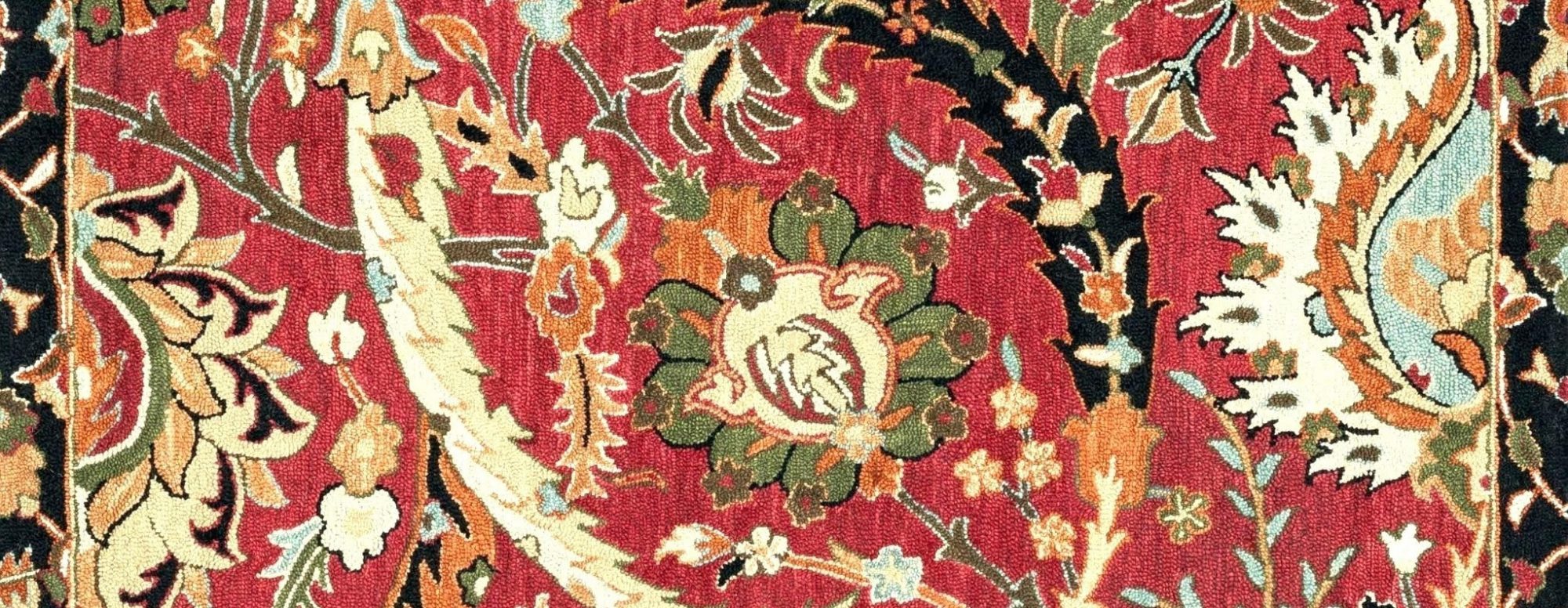
I received an email from Well + Good a few weeks ago asking for an expert quote.
They were doing a story about rugs shedding and wanted to know if particles from shedding rugs could affect your health.
This is something I hadn’t considered before because I’ve had my attention on rugs outgassing toxic chemicals, but apparently the shedding of particles from rugs is bad for your health too.
And apparently this is a big deal because there are A LOT of posts about it on the internet.
A few days ago I received a link to the finished post and learned a few things about rugs shedding and some tips on how to care for your natural fiber area rugs to reduce shedding.
WELL+GOOD: Why Your Rug is Shedding (and How It Could Be Bad for Your Health)
Thoughts about health + illness while lying in bed with the flu
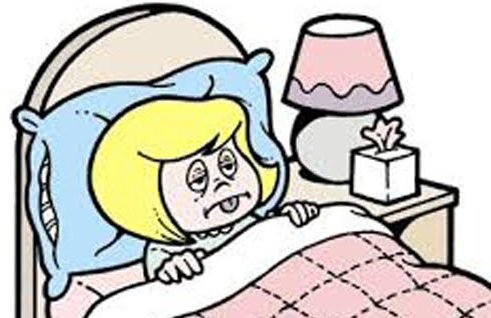
I’m not doing my regular newsletter today because I’ve literally been sick in bed with a flu since I sent the last newsletter.
I rarely get contagious illnesses, and this one was very unusual. It actually started at the beginning of February, but it was so subtle I didn’t recognize it as the flu. What I felt was exhaustion. So much exhaustion I couldn’t get up out of bed in the morning and couldn’t think enough to work unless I drank a cup of coffee (organic, of course!).
Then I started not thinking straight and just forgetting whole sections of time. Like forgetting to enter expenditures in my checking account register (something I routinely do every morning) and not noticing for four days.
And then I started to just feel unbalanced, like my body would just start tipping over when I was standing and I couldn’t walk a straight line.
I went to my Obamacare medical doctor and she just said I needed more sleep. So I slept more hours but the symptoms just kept getting worse and worse over two months until finally last Tuesday my body suddenly burst into aches and fever and coughing and runny nose and sleeping all day and night and can barely get out of bed or eat.
Yesterday was my first day out of bed where I could actually get up and do anything. And my body is no longer exhausted, I can think clearly and walk straight.
But I had some interesting insights.
WHOLEFOOD VITAMIN C
I had the idea I should take a a lot of vitamin C, but I didn’t want to take industrial vitamin C. Instead I kept a big bowl of those baby mandarin oranges by my bed. You know, the kind that are so popular now that are easy to peel and eat, don’t drip and are very sweet. I had just purchased five pound of these, organic, at my local farmer’s market, so I had a great whole food source of vitamin C the was really easy to eat in bed.
THE IMPORTANCE OF PRODUCT PERFORMANCE
Back in 1990, when I was was hired to do research and development for the founding of a green company, we had a formula we used for product development that we found to be true: first make the product work as well or better as the usual product, then make it green. And if you could also give it a competitive price, then it was a green product that would sell.
I also remembered a moment way back in the beginning when I was first coming to terms with the fact that I needed to now live without toxic chemicals to save my life. I didn’t want to give up my favorite things. Like my signature shade of red lipstick that took me so many years to find (ah, what was important to me then!) I made a decision right then that I not only needed to find things that were nontoxic, they also had to be beautiful and pleasurable. Little did I know at that moment that to open the door to the world of things nontoxic was also opening the door to the pleasures of natural fibers against my skin, the deliciousness of organic food and many other delightful experiences of life.
You may remember last week I wrote a post about The Best Toxic Free Toilet Paper. I went to my local independent supermarket and looked on the shelf and purchased two brands that looked similar because they were each made with what looked at first glance to be the same materials from a toxic viewpoint. So I bought a package of each one and brought it home. One turned out to be the best toilet paper I could find. The other turned out to have so many problems I didn’t even include it in the post.
But here’s the kicker for me. The best toilet paper turned out to be soft and lovely to use. The other one was rough and had no consideration of user experience at all.
For me, really, as I pick products I’m looking for products that meet my nontoxic criteria, but they also bring me into living in this whole different delightful world that I love and feel happy in every day. And I don’t tell you that enough.
SOURCES OF SYMPTOMS
In my work I write a lot about the association between symptoms and exposure to toxic chemicals. In this case symptoms are a signal from the body that something has entered the body that it doesn’t like and we need to stop doing that.
But this week in bed with the flue reminded me there are other reasons for symptoms.
The symptoms I was experiencing from the flu virus were actually indicators that my body was hard at work fighting the virus. Symptoms that remove body wastes quickly—like sneezing, coughing, runny nose, diarrhea, vomiting, and the like—are trying to get foreign invaders out of your body so your body can heal. These are symptoms we want to have, which benefit us, and should not be suppressed.
Then there are allergic reactions, which operate in an entirely different way than toxic poisoning. And individual sensitivities.
And finally, symptoms may develop when your body is detoxing to remove toxic chemicals that your body has stored to keep them out of it’s bloodstream. Sleepiness and headaches are often indicators that detox is happening a little too fast.
As uncomfortable as I was, I just waited out my symptoms and let my body do it’s job. And while I could get out of bed today and write this, I’m going to take it easy for the rest of the week so I can full recover and get back to my regular schedule.
ILLNESS AS A TIME OF HEALING AND REST
We tend to think of illness as “something wrong” with our bodies, but this past week, I’ve been realizing how right it has been to be sick right now.
For the past year I’ve been going and going and going from one thing to the next, making major life changes bac-to-back without slowing down for a second.
And my body finally said, “Enough! Rest! Let us heal and restore!”
Our bodies need a balance of activity and rest. It’s during sleep and rest that our bodies repair everything.
THE GIFT OF THIS WEEK’S ILLNESS
The truly amazing part of this experience was to observe that even though my body and mind were being ravaged by this virus, my creative side came out in full force.
I’ve been working on re-imagining my work and designing a new website and while my body was burning up with fever and my mind couldn’t put two sentences together, creative ideas and realizations were coming through just fine day and night. I’ve been keeping a pad of paper next to my bed and it’s full of scribbles and drawings.
It’s like having my body be sick right now is part of the greater creative process, so I can take my attention off everything else I usually do and just have creative time.
I am just getting so much clarity on everything. Wow! I really can’t wait to show this to you.
SEE YOU SOON!
OK, OK, enough for now.
I expect to be back next Tuesday with my usual newsletter and MUCH more very soon.






